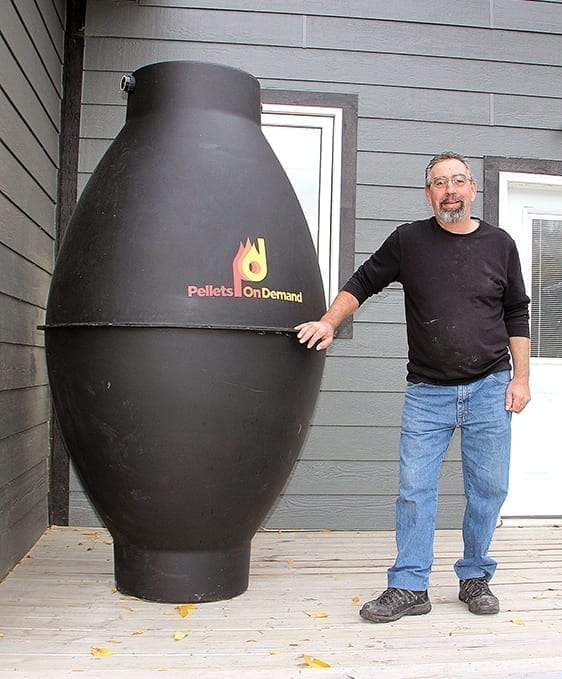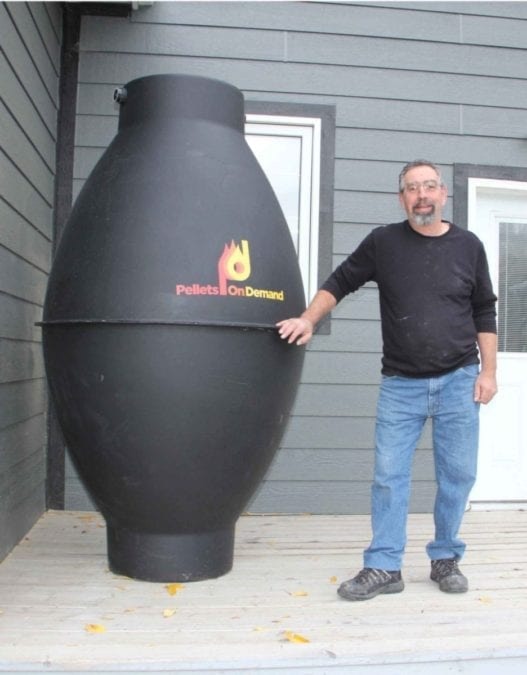A Hay River inventor is close to re-launching sales of his system to conveniently bring wood pellets into homes.
The system is called Pellets On Demand, and was created by contractor Robert Chenard.
A couple of years ago, Chenard sold two of the systems before finding out he had to get approval from the Canadian Standards Association (CSA) for an electrical component.

Paul Bickford/NNSL photoo
"That's the only thing left that we have to do," he said. "Basically, I have to take the whole system, bring it to Vancouver and they're going to test it there. We've already been in contact with them. They know we're coming."
That process is expected to take about a month.
Chenard attributed his lack of knowledge about the CSA requirement to inexperience as an inventor.
"When you deal with inventions, there's a lot of things to think about," he explained.
However, Chenard has taken the time to dramatically improve the appearance of his invention.
It was once made of wood, but now features a fibreglass hopper, which can hold one tonne of wood pellets outside a home, and an inside wall-mounted unit where a homeowner can access the pellets.
Pellets are moved around the storage system by negative pressure, otherwise known as a vacuum. That eliminates the use of augers, and prevents damage to the pellets.
The vacuum process on a delivery truck can also fill a hopper with wood pellets in about 20 minutes.
Chenard makes the hoppers and wall-mounted units at his workshop in Old Town.
As for the two systems he previously sold, Chenard said the unapproved electrical component was removed, and he has been bringing pellets inside the customers' homes.
They will be receiving the updated system free of charge.
Chenard expects to have the new and approved systems ready for sale this year.
"My plan is to use Hay River and the South Slave district as a template for the wood pellet system for the winter," he said.
"If I get 50 units out there this winter, I would be very satisfied with that," he added.
The main benefits of the system, which would cost around $3,000, are that it eliminates the need for homeowners to carry bags of wood pellets into their houses and having pallets of bags on their properties.
At a Sept. 19 candidates' meeting for the upcoming territorial election, Chenard noted he had been turned down for about $7,000 in funding from the Department of Industry, Tourism and Investment (ITI) to help pay for the CSA approval process of the electrical component.
Hay River South incumbent and ITI Minister Wally Schumann said that, as of the dropping of the writ for the election, he does not have anything to do with the day-to-day operations of the department.
However, he defended its record of helping small businesses.
"We gladly support small businesses in the Northwest Territories," Schumann said, adding the department goes above and beyond services offered elsewhere in Canada.
R.J. Simpson, the acclaimed MLA for Hay River North, noted he has seen the evolution of Chenard's invention.
"It's a pretty interesting product," said Simpson, noting it could help address climate change by assisting people to use wood pellets for heating.
"I share your frustration," the MLA told Chenard about the funding issue. "It's a product that could benefit the community and doesn't seem to be getting support."
The inventor said the funding rejection by ITI will not impact the CSA approval process or the sale of the product this year.
Different options for funding are being considered.
Chenard estimated that he has already put over $200,000 into the invention in his own money and time.
Previously, he received GNWT funding to help patent the invention, and there are now patents pending in about 140 countries.
